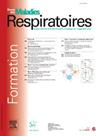[医院入口无烟区调查]。
IF 0.5
4区 医学
Q4 RESPIRATORY SYSTEM
引用次数: 0
摘要
导言在一项关于吸烟率和吸烟意见的调查中,这项工作的重点是在医院入口处设立无烟区的策略:方法:对占据室外空间的公众进行宣传,在2022年11月(无烟月)开展的13次行动中立即收集答复:32%的受访者为吸烟者,其中病人占38%,专业人士占26%,护理专业学生占18%。大多数人表示支持在建筑物入口处禁烟,半数吸烟者认为这是在鼓励他们戒烟或减少吸烟量。然而,四分之一的参与者预计会遇到困难,尤其是 "烟瘾最大 "的吸烟者。在精神科部门,54%的人是吸烟者,他们对这一举措持相对反对的态度。至于非吸烟者,大多数人对烟草味、烟雾在室内空间的渗透、被动吸烟、医院的负面形象以及对生态环境的不利影响表示不适:无烟医院入口倡议对医院有意义且有益。为了取得成功,必须让所有利益相关者(无论是使用者还是专业人员)参与进来,通过在各个层面采用教育和协同方法,共同努力为希望戒烟的吸烟者提供最佳帮助。本文章由计算机程序翻译,如有差异,请以英文原文为准。
Enquête sur la mise en place d’un lieu de santé sans tabac à l’hôpital
Introduction
La stratégie lieu de santé sans tabac (LSST) à l’hôpital s’est appuyée dans ce travail sur une enquête de prévalence et d’opinion sur le tabagisme.
Méthodes
Aller-vers le public dans les espaces extérieurs a permis un recueil immédiat des réponses au cours de 13 interventions pendant le mois sans tabac en 2022.
Résultats
Au total, 32 % étaient fumeurs, 38 % chez les patients, 26 % chez les professionnels et 18 % chez les étudiants infirmiers. La majorité était favorable aux entrées de bâtiments sans fumée. La moitié des fumeurs l’envisageait comme un encouragement à arrêter ou à réduire. Un quart anticipait des difficultés, notamment ceux ayant les niveaux de tabagisme les plus élevés. En psychiatrie, 54 % étaient fumeurs et plutôt peu favorables au LSST. Les non-fumeurs, majoritaires, ont exprimé des commentaires sur les gênes quant à l’odeur, le retour de la fumée vers les espaces intérieurs, le tabagisme passif, l’image négative et l’impact écologique.
Conclusions
La démarche LSST est pertinente et salutaire à l’hôpital. Pour aboutir, elle doit impliquer l’ensemble des acteurs, professionnels et usagers, optimiser l’aide au sevrage pour les fumeurs, s’appuyer sur une démarche pédagogique et synergique à tous les niveaux.
Introduction
In a prevalence and opinion survey on smoking, this work focused on a strategy favoring tobacco-free areas at hospital entrances.
Methods
Outreach to the public occupying outdoor spaces led to immediate collection of responses over the course of 13 actions carried out in November 2022, a tobacco-free month.
Results
Thirty-two percent of the persons interrogated were smokers, 38% among patients, 26% among professionals and 18% among nursing students. A majority expressed support for smoke-free building entrances, which were viewed by half of the smokers as an encouragement to quit or cut down on their consumption. However, a quarter of participants anticipated difficulties, particularly the “heaviest” smokers. In the psychiatry sector, 54% were smokers, and they were relatively unfavorable to the initiative. As for non-smokers, most voiced discomfort regarding the smell of tobacco, the infiltration of smoke in indoor spaces, passive smoking, a negative image of the hospital, and the detrimental ecological impact.
Conclusions
The tobacco-free hospital entrance initiative is relevant and of benefit to hospitals. In order to succeed, it must involve all stakeholders, whether they are users or professionals, in a concerted attempt to optimize assistance to smokers wishing to quit, by applying an educational and synergistic approach at all levels.
求助全文
通过发布文献求助,成功后即可免费获取论文全文。
去求助
来源期刊

Revue des maladies respiratoires
医学-呼吸系统
CiteScore
1.10
自引率
16.70%
发文量
168
审稿时长
4-8 weeks
期刊介绍:
La Revue des Maladies Respiratoires est l''organe officiel d''expression scientifique de la Société de Pneumologie de Langue Française (SPLF). Il s''agit d''un média professionnel francophone, à vocation internationale et accessible ici.
La Revue des Maladies Respiratoires est un outil de formation professionnelle post-universitaire pour l''ensemble de la communauté pneumologique francophone. Elle publie sur son site différentes variétés d''articles scientifiques concernant la Pneumologie :
- Editoriaux,
- Articles originaux,
- Revues générales,
- Articles de synthèses,
- Recommandations d''experts et textes de consensus,
- Séries thématiques,
- Cas cliniques,
- Articles « images et diagnostics »,
- Fiches techniques,
- Lettres à la rédaction.
 求助内容:
求助内容: 应助结果提醒方式:
应助结果提醒方式:


